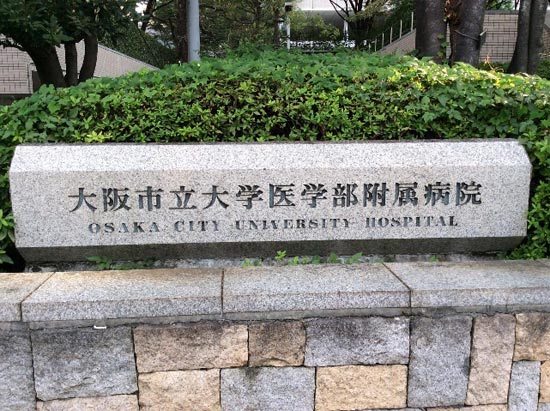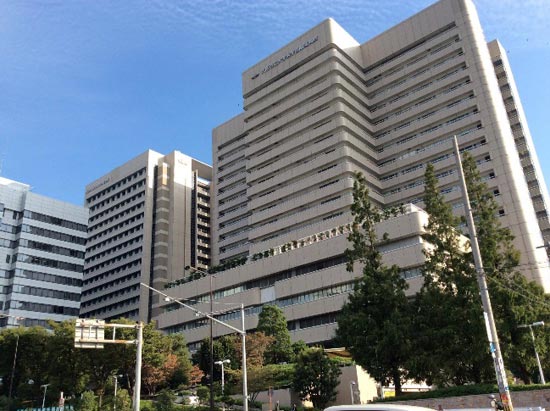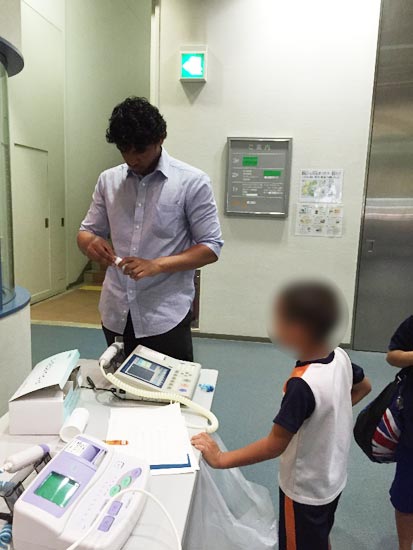Exchange student Elective Report
The two week elective spent with the Paediatrics department at Osaka City University Hospital in August 2016 has undoubtedly been the most integral and enjoyable rotation that I have experienced throughout the course of my medical training. From the amazing doctors to the delightful patients, my view of healthcare provision at Osaka City University Hospital could not be more positive. The rotation has had such an effect on me that I am eager to return to experience more!
On my first day I was provided with everything I needed, and was introduced to my supervisor Dr Tokuhara. The warm welcome I received was wonderful, and I was given a tour of the department and the paediatric ward. The view from the ward (17th floor) is stunning.
Osaka City University Hospital is one of the leading hospitals for Paediatric care in Japan. Throughout the two weeks I was able to experience a wide range of sub-specialties within paediatrics. The elective was extremely well organised, and the department were eager to involve and accommodate me.
My time with the haematology team provided me with a greater understanding of the prevalence and treatment options regarding leukaemia. Dr Nakaya was keen to teach, and assisted my learning greatly throughout my time with haematology. It was my first experience seeing patients with Acute Lymphoblastic Leukaemia (ALL), and I was able to observe and participate in developing blood films. Looking at samples under a microscope also helped my understanding. Dr Nakaya was also kind enough to show me presentations and literature on blood group antigens, methotrexate therapy and acidosis/alkalosis. Witnessing lumbar punctures for the collection of CSF was valuable, and the methods employed to reassure and relax each child during the procedure was admirable, and arguably some of the best methods I have seen.
I was able to see a wide range of cases on rotation with paediatric neurology. Epilepsy, West Syndrome and Fabry disease are just some of the many conditions I had the benefit of seeing. Being on the ward gave me the opportunity to see the progression of patients throughout the fortnight. Dr Hoshina taught me a great deal, using videos showing infantile spasms and seizures. Trying to identify when a seizure has occurred can be very subtle, and can be difficult for a medical student! Dr Hoshina helped identify these and I feel that I am more confident now. I was given the opportunity to analyse EEG recordings. Furthermore, I sat in on a clinic where I was introduced to Fabry disease by Dr Seto. In addition, a case of nystagmus in a 4 month old was highly memorable.
Endocrinology with Dr Hirose was focused on diabetes. The clinic I attended gave me insight into the criteria and management for diabetics type 1 and 2 in Japan. The use of the insulin pump is common, and an emphasis on patient comfort is placed in order for optimum glycaemic control and adherence to diets. Monitoring is very regular, and all the patients and parents at the clinic were pleased and satisfied, despite it being a difficult disease for children.
My time with immunology was really fun. Following the entire process of allergy testing was very rewarding. Dr Kasuga was helpful by providing literature regarding trials in Israel, relating to early exposure to peanuts. She also explained the process of allergy testing and the precautions that are required. We tested children with food substances that they had never been exposed to before. Special preparations of peanuts, egg and soya were fed, and attentive periods of observation from the team of doctors were mixed with entertaining the kids! We were looking for any obvious rashes, nausea/vomiting, heart rate, respiratory rate, and other signs of allergic reaction. It was a pleasure to see the joy and relief in mothers when the food exposure did not cause any reaction. I was also very lucky to get the opportunity to travel to a swimming pool with Dr Kasuga to assess asthma severity in children after exercise. We conducted spirometry and forced exhaled nitric oxide (FeNO) measurements on the children after they had completed an hour of swimming. I was delighted that I was able to perform these tests learn more about the equipment, and understand the changes in FEV1 and FVC.
The Neonatal Intensive Care Unit (NICU) at Osaka City University Hospital is impressive. Dr Nomura provided guided me through the unit and its facilities. I saw neonates with low birth weight (LBW), extremely low birth weight (ELBW), chronic lung disease, respiratory distress syndrome and transient tachypnea of neonate (TTN). Seeing some neonates on an outpatient basis at clinic was good learning. I was also able to witness a caesarean section in theatre, and the subsequent newborn baby check. I was fortunate to be able to clean and wipe the newborn, something I have never done before! In addition, the teaching I received on neonatal resuscitation was excellent. I, along with the Year 5 students, were able to run through scenarios using a model baby. Dr Nomura explained the algorithm and in teams of three we simulated the scenario. Working in a team with the other students was a lot of fun, and Dr Nomura was very helpful and great to spend time with. My skills certainly improved as a result of the session.
The gastroenterology clinics I attended with Dr Tokuhara were fascinating due to the variety of symptoms presented, and the process by which investigations are chosen and performed. One such example is citrin deficiency, a rare inherited metabolic condition of which many of my colleagues in London have not heard about! Furthermore, I had the privilege of seeing multiple ultrasonography scans with Dr Cho. The equipment is almost identical to the ones I have seen in London, and the method is also efficient and comparable. However, I also witnessed many FibroScan investigations, which I had not seen before. It is a non-invasive exam that examines liver stiffness using sound waves. Osaka City University Hospital is the only hospital in Japan that performs the FibroScan on children, so it was great experience for me. In addition, I was able to see the use of contrast reagent on a patient with severe constipation, and watch the imaging live as the contrast spread.
I was able to spend an afternoon with Dr Tokuhara observing four month old baby checks at a health centre clinic. Refreshing my knowledge on milestones and learning how to identify delays in development left my feeling like an expert in the field! The efficiency and structure of the process was impressive and memorable. Furthermore, seeing some of the laboratory work that is currently being conducted by some of the paediatric doctors was a privilege, and has developed my enthusiasm for it. I have, since my return, been reading relevant literature, showing that it has had a lasting effect on me.
Osaka is a wonderful city. There is always something to do or somewhere to go. The hubs of Namba and Umeda are great for nightlife with an abundance of bars and restaurants.
Around the hospital is Tennoji, a place I became very familiar with, and it is a great location. There is a mall and some unique restaurants nearby that had some of the best food I tried during my stay.
Other cities such as Kobe and Kyoto are short train journeys on the JR line, and I spent a few days in each. Travelling around is very easy and convenient.
I would also like to thank Dr Tokuhara and the whole of the paediatric department for creating an amazing experience for me. They gave so much and my time could not have been better.
I will certainly be returning soon as I have made friends in my short time and can't wait to see them again. Working in Japan in the future is also a possibility as the culture and
work environment is highly appealing to me. In my opinion, it has been the most enjoyable and educational rotation of my university studies so far,
and I am eternally grateful that Osaka City University gave me this wonderful opportunity.
Thank you for everything.





















